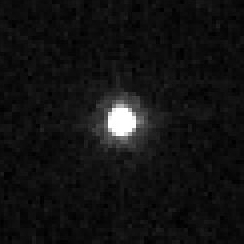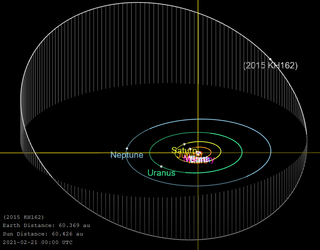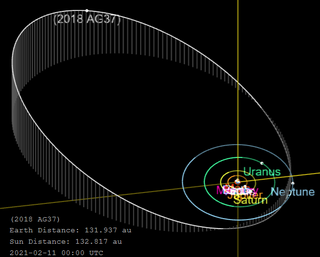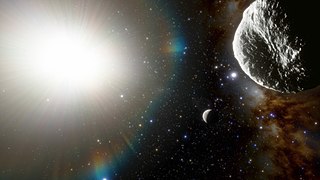Related Research Articles
385571 Otrera, provisional designation 2004 UP10, is a Neptune trojan leading Neptune's orbit in the outer Solar System. It was discovered by American astronomers Scott Sheppard and Chad Trujillo at Las Campanas Observatory on 16 October 2004. It measures approximately 100 kilometers in diameter and was the second such body to be discovered after 2001 QR322.
2005 TN53 is an inclined Neptune trojan leading Neptune's orbit in the outer Solar System, approximately 80 kilometers in diameter. It was first observed on 7 October 2005, by American astronomers Scott Sheppard and Chad Trujillo at Las Campanas Observatory in the Atacama desert of Chile. It was the third such body to be discovered, and the first with a significant orbital inclination, which showed that the population as a whole is very dynamically excited.
385695 Clete, provisional designation 2005 TO74, is a Neptune trojan, co-orbital with the ice giant Neptune, approximately 97 kilometers (60 miles) in diameter. It was named after Clete, one of the Amazons from Greek mythology. The minor planet was discovered on 8 October 2005, by American astronomers Scott Sheppard and Chad Trujillo at Las Campanas Observatory in Chile. 23 known Neptune trojans have already been discovered.

(15875) 1996 TP66 (provisional designation 1996 TP66) is a resonant trans-Neptunian object of the plutino population, located in the outermost region of the Solar System, approximately 154 kilometers (96 miles) in diameter. It was discovered on 11 October 1996, by astronomers Jane Luu, David C. Jewitt and Chad Trujillo at the Mauna Kea Observatories, Hawaii, in the United States. The very reddish RR-type with a highly eccentric orbit has been near its perihelion around the time of its discovery. This minor planet was numbered in 2000 and has since not been named. It is probably not a dwarf planet candidate.

(202421) 2005 UQ513 (provisional designation 2005 UQ513) is a cubewano with an absolute magnitude of 3.97. Its spectrum has a weak signature of absorption by water ice. Like Quaoar, it has a very red spectrum, which indicates that its surface probably contains many complex, processed organic molecules. Its light curve shows variations of Δm=0.3 mag, but no period has been determined.

471143 Dziewanna (provisional designation 2010 EK139) is a trans-Neptunian object in the scattered disc, orbiting the Sun in the outermost region of the Solar System.
2010 KZ39 is a trans-Neptunian object orbiting the Sun as a detached object in the outer reaches of the Solar System. The object was first observed on 21 May 2010 by astronomers Andrzej Udalski, Scott Sheppard, M. Szymanski and Chad Trujillo at the Las Campañas Observatory in Chile.

(523622) 2007 TG422 (provisional designation 2007 TG422) is a trans-Neptunian object on a highly eccentric orbit in the scattered disc region at the edge of Solar System. Approximately 260 kilometers (160 miles) in diameter, it was discovered on 3 October 2007 by astronomers Andrew Becker, Andrew Puckett and Jeremy Kubica during the Sloan Digital Sky Survey at Apache Point Observatory in New Mexico, United States. According to American astronomer Michael Brown, the bluish object is "possibly" a dwarf planet. It belongs to a group of objects studied in 2014, which led to the proposition of the hypothetical Planet Nine.
(589683) 2010 RF43 (provisional designation 2010 RF43) is a large trans-Neptunian object orbiting in the scattered disc in the outermost regions of the Solar System. The object was discovered on 9 September 2010, by American astronomers David Rabinowitz, Megan Schwamb and Suzanne Tourtellotte at ESO's La Silla Observatory in northern Chile.
1999 TR11, is a resonant trans-Neptunian object from the Kuiper belt, located in the outermost region of the Solar System. The reddish plutino measures approximately 93 kilometers (58 miles) in diameter. It was first observed on 9 October 1999, by American astronomer Scott Sheppard at the Mauna Kea Observatories with the University of Hawaii's 2.2-meter telescope.

2012 VP113, also known by its nickname "Biden", is a trans-Neptunian object of the sednoid population, located in the outermost reaches of the Solar System. It was first observed on 5 November 2012 by American astronomers Scott Sheppard and Chad Trujillo at the Cerro Tololo Inter-American Observatory in Chile. The discovery was announced on 26 March 2014. The object probably measures somewhere between 300 and 1000 km in diameter, possibly large enough to be a dwarf planet.
(523671) 2013 FZ27 (provisional designation 2013 FZ27) is a trans-Neptunian object located in the Kuiper belt in the outermost region of the Solar System, approximately 570 kilometers (350 miles) in diameter. It was discovered on 16 March 2013, by American astronomers Scott Sheppard and Chad Trujillo at the CTIO in Chile. Numbered in 2018, this minor planet has not been named.

2014 FC69 is a trans-Neptunian object of the scattered disc on an eccentric orbit in the outermost region of the Solar System. It was first observed on 25 March 2014, by American astronomers Scott Sheppard and Chad Trujillo at the Cerro Tololo Observatory in Chile. It is one of the most distant objects from the Sun, even further away than Sedna.

2015 KH162 is a large trans-Neptunian object orbiting in the scattered disc region of the outermost Solar System. First observed in 2015, this minor planet is one of the most distant objects from the Sun at 60.6 AU, or twice as far as Neptune.

2018 VG18 is a distant trans-Neptunian object that was discovered well beyond 100 AU (15 billion km) from the Sun. It was first observed on 10 November 2018 by astronomers Scott Sheppard, David Tholen, and Chad Trujillo during a search for distant trans-Neptunian objects whose orbits might be gravitationally influenced by the hypothetical Planet Nine. They announced their discovery on 17 December 2018 and nicknamed the object "Farout" to emphasize its distance from the Sun.

2018 AG37 is a distant trans-Neptunian object and centaur that was discovered 132.2 ± 1.5 AU (19.78 ± 0.22 billion km) from the Sun, farther than any other currently observable known object in the Solar System. Imaged in January 2018 during a search for the hypothetical Planet Nine, the confirmation of this object was announced in a press release in February 2021 by astronomers Scott Sheppard, David Tholen, and Chad Trujillo. The object was nicknamed "FarFarOut" to emphasize its distance from the Sun.
2014 ST373 (prov. designation:2014 ST373) is a trans-Neptunian object and a detached object from the outermost region of the Solar System. With a perihelion of 50.2 AU, it belongs to the top 10 minor planets with the highest known perihelia of the Solar System. and is neither a scattered disc nor an extreme trans-Neptunian object. It measures approximately 370 kilometers (230 miles) in diameter and was first observed on 25 September 2014, by astronomers using the Dark Energy Camera (DECam) at Cerro Tololo Inter-American Observatory in Chile.

2021 PH27 is a near-Earth asteroid of the Atira group. It was discovered by Scott Sheppard using the Dark Energy Survey's DECam imager at NOIRLab's Cerro Tololo Inter-American Observatory on 13 August 2021. 2021 PH27 has the smallest semi-major axis and shortest orbital period among all known asteroids as of 2021, with a velocity at perihelion of 106 km/s (240,000 mph). It also has the largest value of the relativistic perihelion shift, 1.6 times that of Mercury. With an absolute magnitude of 17.7, the asteroid is estimated to be larger than 1 kilometer (0.6 miles) in diameter.
2015 FG415 is a trans-Neptunian object from the scattered disc, located in the outermost region of the Solar System. It was discovered on 17 March 2015, by American astronomer Scott Sheppard at the Mauna Kea Observatories, Hawaii, and received the provisional designation 2015 FG415. As of 2021, it is the 9th-most-distant object from the Sun at 87.2 AU and measures approximately 280 kilometers (170 miles) in diameter.
2021 RR205 is an extreme trans-Neptunian object and sednoid discovered by astronomers Scott Sheppard, David Tholen, and Chad Trujillo with the Subaru Telescope at Mauna Kea Observatory on 5 September 2021. It resides beyond the outer extent of the Kuiper belt on a distant and highly eccentric orbit detached from Neptune's gravitational influence, with a large perihelion distance of 55.5 astronomical units (AU). Its large orbital semi-major axis (~1,000 AU) suggests it is potentially from the inner Oort cloud. Like 2013 SY99, 2021 RR205 lies in the 50–75 AU perihelion gap that separates the detached objects from the more distant sednoids; dynamical studies indicate that such objects in the inner edge this gap weakly experience "diffusion", or inward orbital migration due to minuscule perturbations by Neptune.
References
- 1 2 3 4 5 "JPL Small-Body Database Browser: 2005 TN74" . Retrieved 30 March 2016.
- ↑ Most SDOs have a perihelion distance greater than 35AU and an eccentricity of more than 0.3.
- ↑ "Orbit Fit and Astrometric record for 05TN74". Archived from the original on 29 April 2018. Retrieved 7 March 2012.
- ↑ Wasserman, L. H.; Buie, M. W.; Marsden, B. G. (5 October 2006). "MPEC 2006-T35 : 2005 PR21, 2005 PT21, 2005 PU21, 2005 TN74". Minor Planet Center . Retrieved 12 May 2008.
- ↑ Sheppard, S. S.; Trujillo, C. A.; Marsden, B. G. (31 October 2005). "MPEC 2005-U97 : 2005 TN74, 2005 TO74". Minor Planet Center. Retrieved 12 May 2008.
- ↑ "Absolute Magnitude (H)". Archived from the original on 2 March 2001. Retrieved 11 May 2008.